Analysis of Leadership, Management, and Operations at Tesco: A Report
VerifiedAdded on 2022/12/29
|14
|4389
|50
Report
AI Summary
This report provides an in-depth analysis of leadership and management practices at Tesco, a multinational retail giant. It begins by defining the roles and characteristics of leaders and managers, contrasting their responsibilities and contributions to the organization. The report then delves into the specific roles of leaders and managers within Tesco, examining how they navigate various situations, such as employee hiring and store launches. Furthermore, it applies and assesses the effectiveness of different leadership theories and models, including situational, systems, and contingency leadership, within the Tesco context. The report also explores the key approaches to operations management and explains the importance of operations management in achieving business objectives. Finally, it assesses the factors within the business environment that impact upon operational management at Tesco. The report highlights the strengths and weaknesses of different approaches to situations within the work environment, providing a comprehensive overview of leadership, management, and operational strategies at Tesco. This report is available on Desklib, a platform providing AI-based study tools for students.
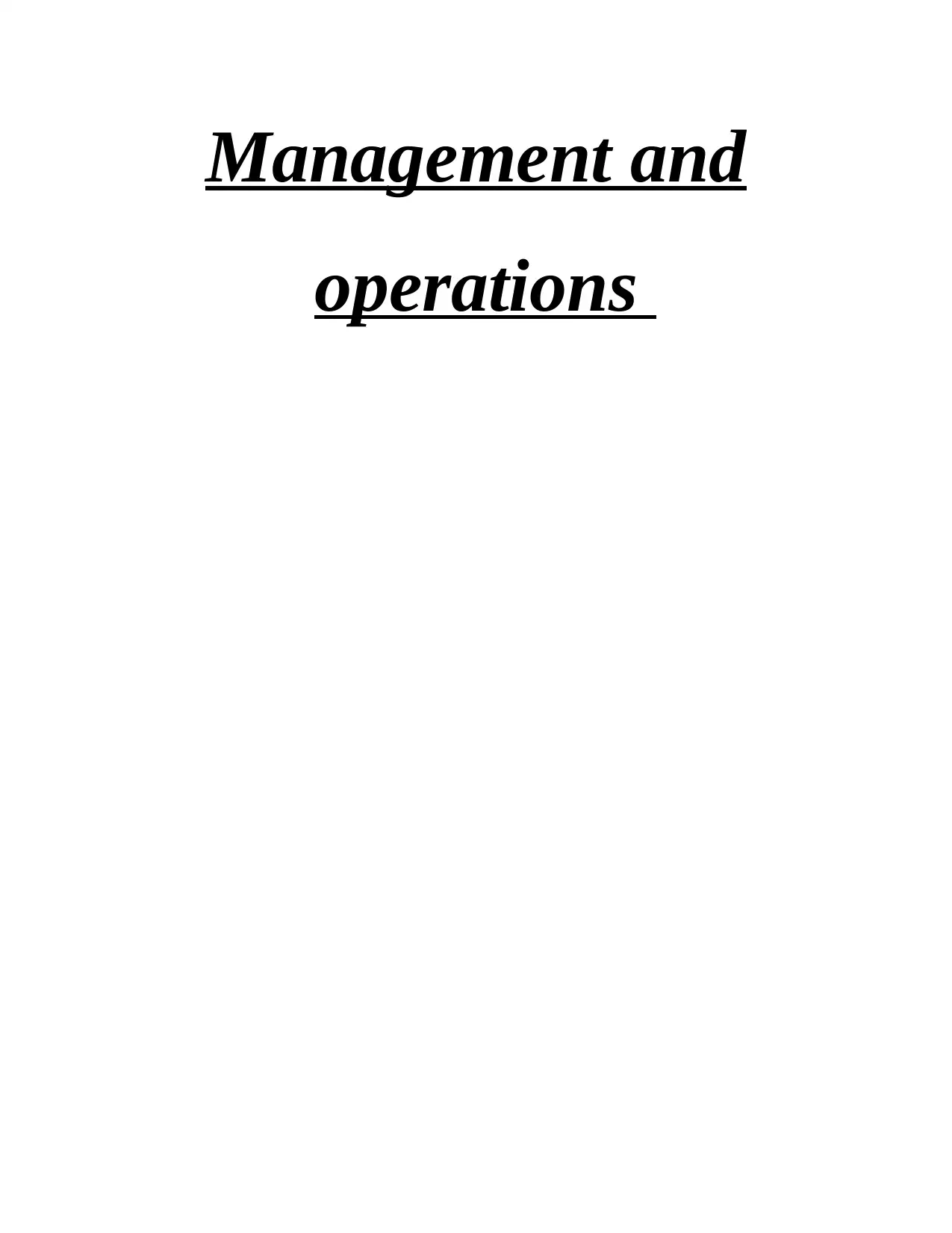
Management and
operations
operations
Paraphrase This Document
Need a fresh take? Get an instant paraphrase of this document with our AI Paraphraser
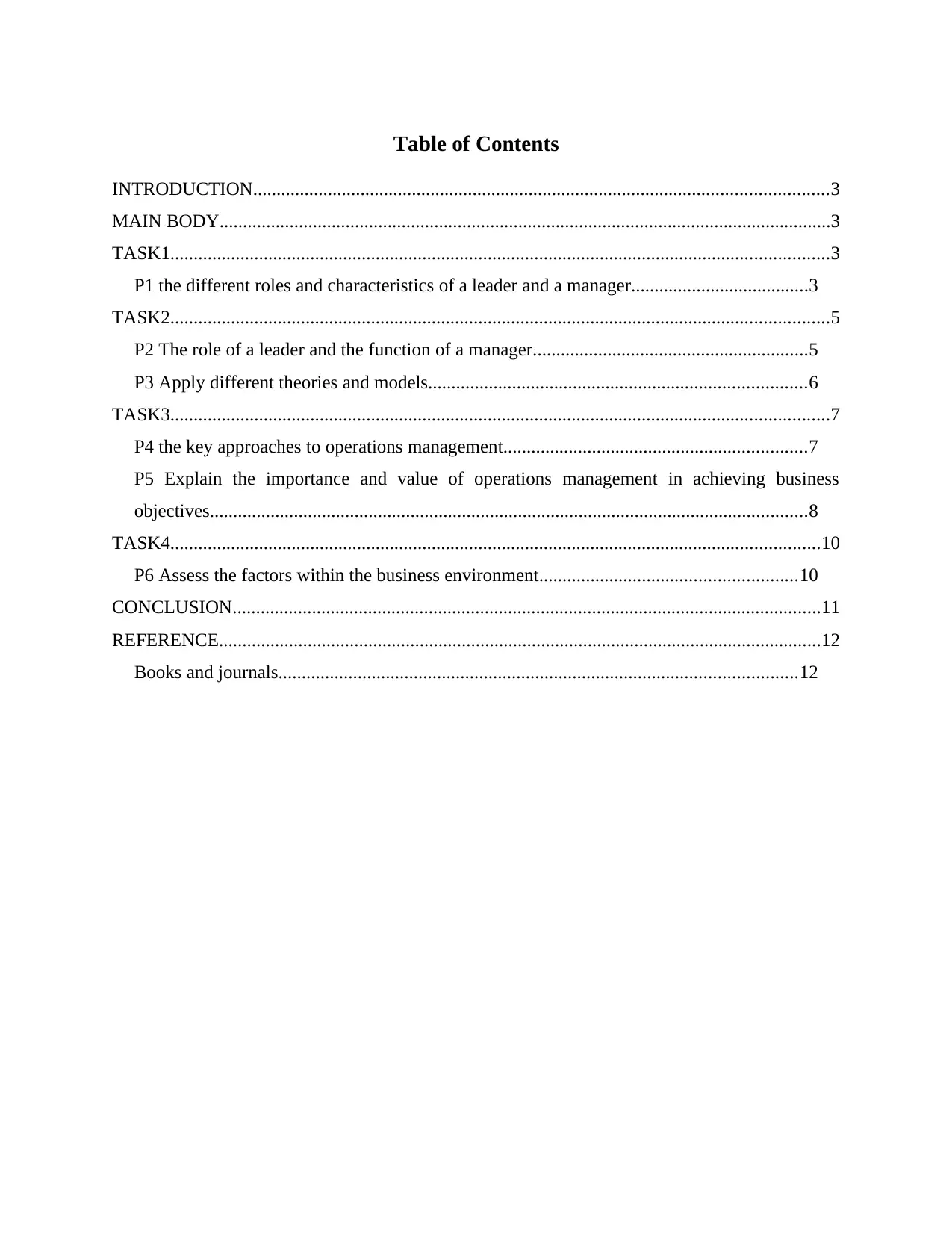
Table of Contents
INTRODUCTION...........................................................................................................................3
MAIN BODY...................................................................................................................................3
TASK1.............................................................................................................................................3
P1 the different roles and characteristics of a leader and a manager......................................3
TASK2.............................................................................................................................................5
P2 The role of a leader and the function of a manager...........................................................5
P3 Apply different theories and models.................................................................................6
TASK3.............................................................................................................................................7
P4 the key approaches to operations management.................................................................7
P5 Explain the importance and value of operations management in achieving business
objectives................................................................................................................................8
TASK4...........................................................................................................................................10
P6 Assess the factors within the business environment.......................................................10
CONCLUSION..............................................................................................................................11
REFERENCE.................................................................................................................................12
Books and journals...............................................................................................................12
INTRODUCTION...........................................................................................................................3
MAIN BODY...................................................................................................................................3
TASK1.............................................................................................................................................3
P1 the different roles and characteristics of a leader and a manager......................................3
TASK2.............................................................................................................................................5
P2 The role of a leader and the function of a manager...........................................................5
P3 Apply different theories and models.................................................................................6
TASK3.............................................................................................................................................7
P4 the key approaches to operations management.................................................................7
P5 Explain the importance and value of operations management in achieving business
objectives................................................................................................................................8
TASK4...........................................................................................................................................10
P6 Assess the factors within the business environment.......................................................10
CONCLUSION..............................................................................................................................11
REFERENCE.................................................................................................................................12
Books and journals...............................................................................................................12
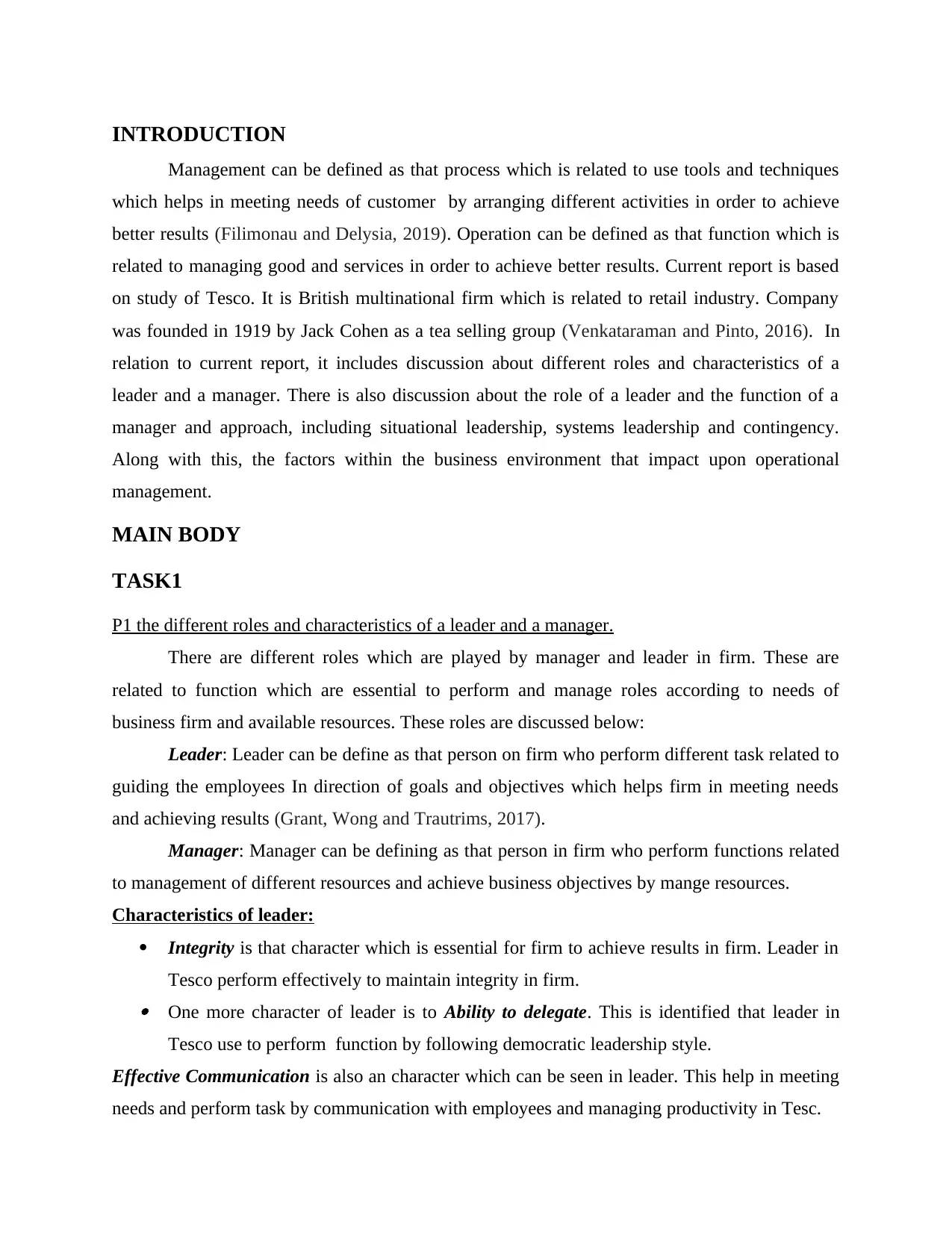
INTRODUCTION
Management can be defined as that process which is related to use tools and techniques
which helps in meeting needs of customer by arranging different activities in order to achieve
better results (Filimonau and Delysia, 2019). Operation can be defined as that function which is
related to managing good and services in order to achieve better results. Current report is based
on study of Tesco. It is British multinational firm which is related to retail industry. Company
was founded in 1919 by Jack Cohen as a tea selling group (Venkataraman and Pinto, 2016). In
relation to current report, it includes discussion about different roles and characteristics of a
leader and a manager. There is also discussion about the role of a leader and the function of a
manager and approach, including situational leadership, systems leadership and contingency.
Along with this, the factors within the business environment that impact upon operational
management.
MAIN BODY
TASK1
P1 the different roles and characteristics of a leader and a manager.
There are different roles which are played by manager and leader in firm. These are
related to function which are essential to perform and manage roles according to needs of
business firm and available resources. These roles are discussed below:
Leader: Leader can be define as that person on firm who perform different task related to
guiding the employees In direction of goals and objectives which helps firm in meeting needs
and achieving results (Grant, Wong and Trautrims, 2017).
Manager: Manager can be defining as that person in firm who perform functions related
to management of different resources and achieve business objectives by mange resources.
Characteristics of leader:
Integrity is that character which is essential for firm to achieve results in firm. Leader in
Tesco perform effectively to maintain integrity in firm. One more character of leader is to Ability to delegate. This is identified that leader in
Tesco use to perform function by following democratic leadership style.
Effective Communication is also an character which can be seen in leader. This help in meeting
needs and perform task by communication with employees and managing productivity in Tesc.
Management can be defined as that process which is related to use tools and techniques
which helps in meeting needs of customer by arranging different activities in order to achieve
better results (Filimonau and Delysia, 2019). Operation can be defined as that function which is
related to managing good and services in order to achieve better results. Current report is based
on study of Tesco. It is British multinational firm which is related to retail industry. Company
was founded in 1919 by Jack Cohen as a tea selling group (Venkataraman and Pinto, 2016). In
relation to current report, it includes discussion about different roles and characteristics of a
leader and a manager. There is also discussion about the role of a leader and the function of a
manager and approach, including situational leadership, systems leadership and contingency.
Along with this, the factors within the business environment that impact upon operational
management.
MAIN BODY
TASK1
P1 the different roles and characteristics of a leader and a manager.
There are different roles which are played by manager and leader in firm. These are
related to function which are essential to perform and manage roles according to needs of
business firm and available resources. These roles are discussed below:
Leader: Leader can be define as that person on firm who perform different task related to
guiding the employees In direction of goals and objectives which helps firm in meeting needs
and achieving results (Grant, Wong and Trautrims, 2017).
Manager: Manager can be defining as that person in firm who perform functions related
to management of different resources and achieve business objectives by mange resources.
Characteristics of leader:
Integrity is that character which is essential for firm to achieve results in firm. Leader in
Tesco perform effectively to maintain integrity in firm. One more character of leader is to Ability to delegate. This is identified that leader in
Tesco use to perform function by following democratic leadership style.
Effective Communication is also an character which can be seen in leader. This help in meeting
needs and perform task by communication with employees and managing productivity in Tesc.
⊘ This is a preview!⊘
Do you want full access?
Subscribe today to unlock all pages.

Trusted by 1+ million students worldwide
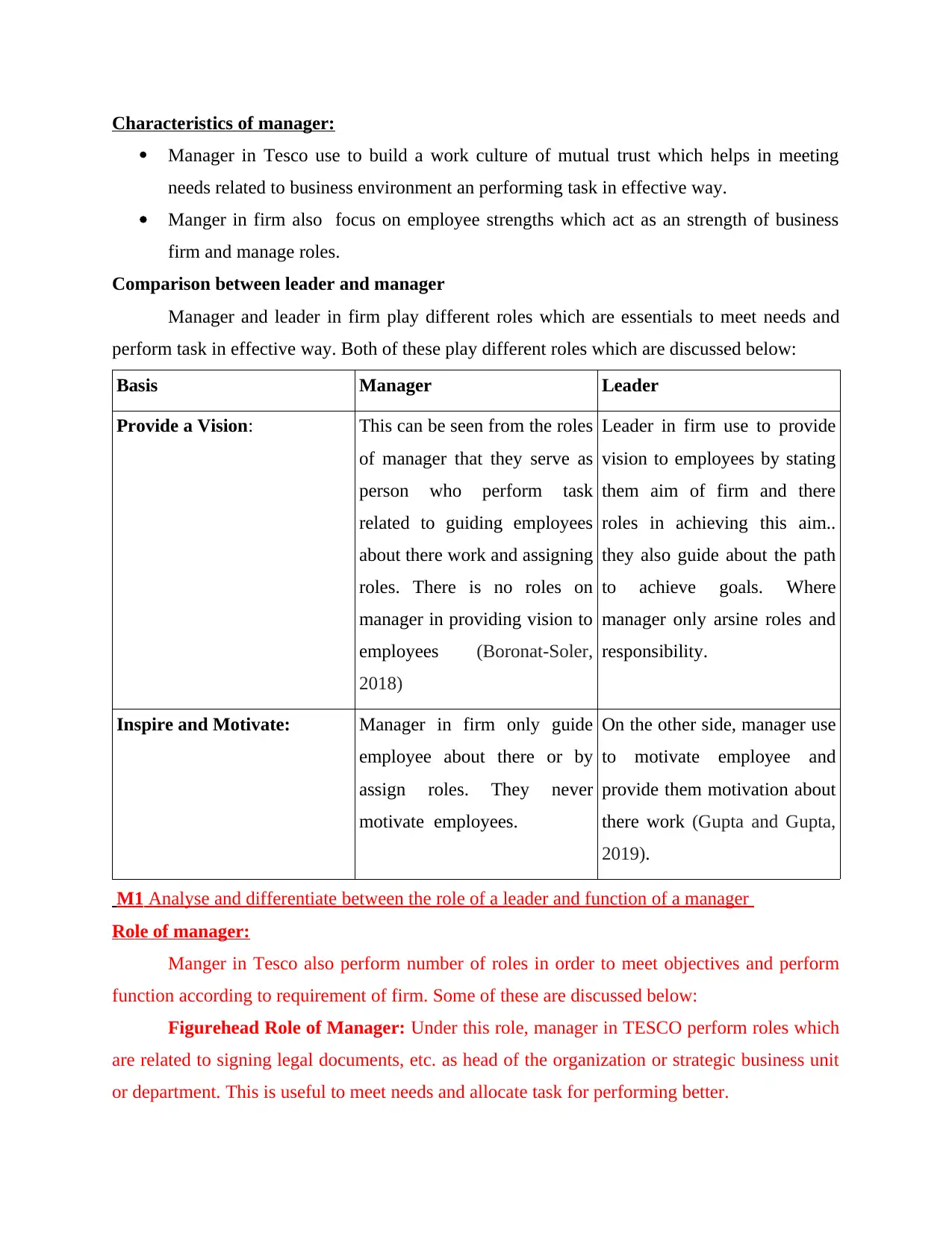
Characteristics of manager:
Manager in Tesco use to build a work culture of mutual trust which helps in meeting
needs related to business environment an performing task in effective way.
Manger in firm also focus on employee strengths which act as an strength of business
firm and manage roles.
Comparison between leader and manager
Manager and leader in firm play different roles which are essentials to meet needs and
perform task in effective way. Both of these play different roles which are discussed below:
Basis Manager Leader
Provide a Vision: This can be seen from the roles
of manager that they serve as
person who perform task
related to guiding employees
about there work and assigning
roles. There is no roles on
manager in providing vision to
employees (Boronat-Soler,
2018)
Leader in firm use to provide
vision to employees by stating
them aim of firm and there
roles in achieving this aim..
they also guide about the path
to achieve goals. Where
manager only arsine roles and
responsibility.
Inspire and Motivate: Manager in firm only guide
employee about there or by
assign roles. They never
motivate employees.
On the other side, manager use
to motivate employee and
provide them motivation about
there work (Gupta and Gupta,
2019).
M1 Analyse and differentiate between the role of a leader and function of a manager
Role of manager:
Manger in Tesco also perform number of roles in order to meet objectives and perform
function according to requirement of firm. Some of these are discussed below:
Figurehead Role of Manager: Under this role, manager in TESCO perform roles which
are related to signing legal documents, etc. as head of the organization or strategic business unit
or department. This is useful to meet needs and allocate task for performing better.
Manager in Tesco use to build a work culture of mutual trust which helps in meeting
needs related to business environment an performing task in effective way.
Manger in firm also focus on employee strengths which act as an strength of business
firm and manage roles.
Comparison between leader and manager
Manager and leader in firm play different roles which are essentials to meet needs and
perform task in effective way. Both of these play different roles which are discussed below:
Basis Manager Leader
Provide a Vision: This can be seen from the roles
of manager that they serve as
person who perform task
related to guiding employees
about there work and assigning
roles. There is no roles on
manager in providing vision to
employees (Boronat-Soler,
2018)
Leader in firm use to provide
vision to employees by stating
them aim of firm and there
roles in achieving this aim..
they also guide about the path
to achieve goals. Where
manager only arsine roles and
responsibility.
Inspire and Motivate: Manager in firm only guide
employee about there or by
assign roles. They never
motivate employees.
On the other side, manager use
to motivate employee and
provide them motivation about
there work (Gupta and Gupta,
2019).
M1 Analyse and differentiate between the role of a leader and function of a manager
Role of manager:
Manger in Tesco also perform number of roles in order to meet objectives and perform
function according to requirement of firm. Some of these are discussed below:
Figurehead Role of Manager: Under this role, manager in TESCO perform roles which
are related to signing legal documents, etc. as head of the organization or strategic business unit
or department. This is useful to meet needs and allocate task for performing better.
Paraphrase This Document
Need a fresh take? Get an instant paraphrase of this document with our AI Paraphraser
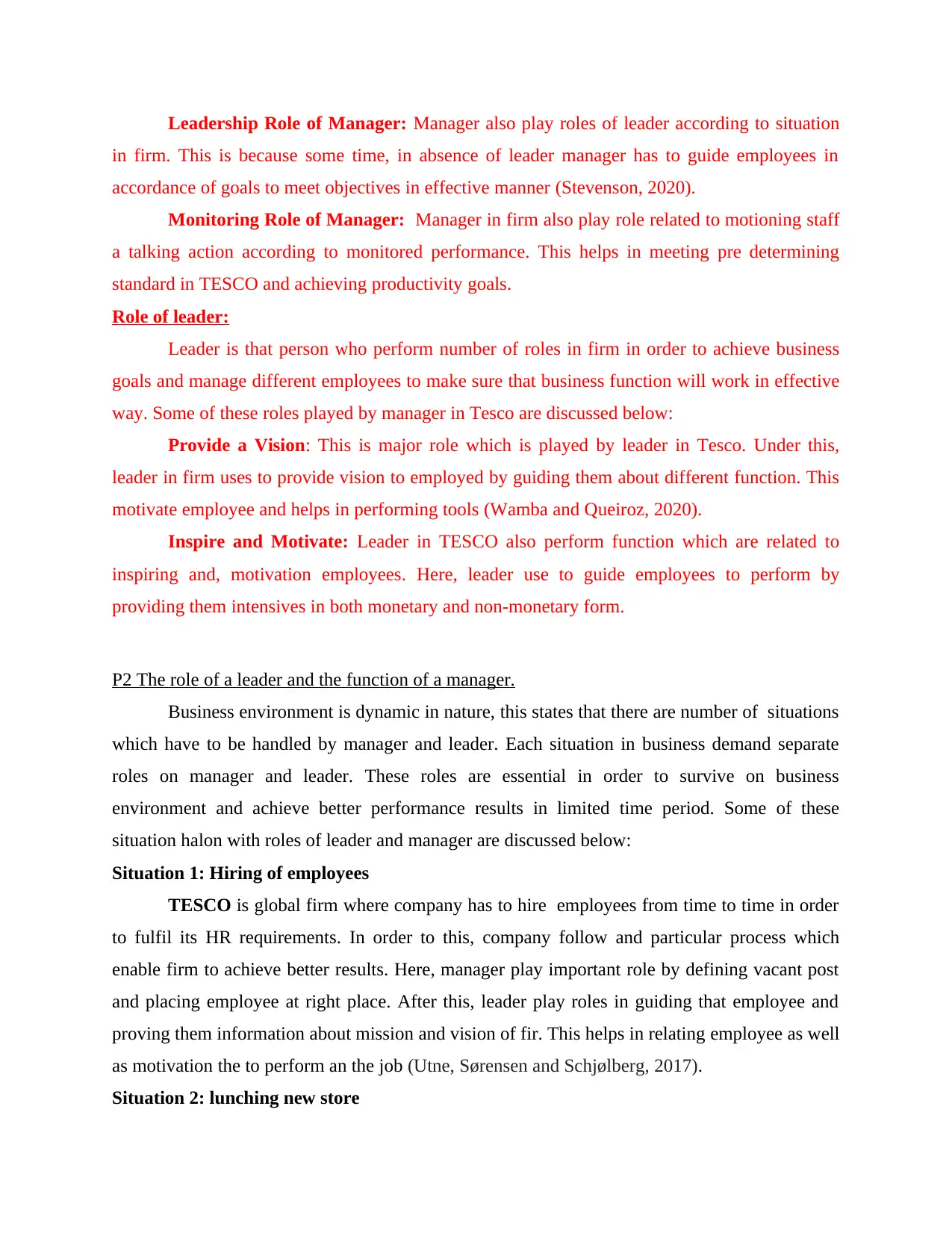
Leadership Role of Manager: Manager also play roles of leader according to situation
in firm. This is because some time, in absence of leader manager has to guide employees in
accordance of goals to meet objectives in effective manner (Stevenson, 2020).
Monitoring Role of Manager: Manager in firm also play role related to motioning staff
a talking action according to monitored performance. This helps in meeting pre determining
standard in TESCO and achieving productivity goals.
Role of leader:
Leader is that person who perform number of roles in firm in order to achieve business
goals and manage different employees to make sure that business function will work in effective
way. Some of these roles played by manager in Tesco are discussed below:
Provide a Vision: This is major role which is played by leader in Tesco. Under this,
leader in firm uses to provide vision to employed by guiding them about different function. This
motivate employee and helps in performing tools (Wamba and Queiroz, 2020).
Inspire and Motivate: Leader in TESCO also perform function which are related to
inspiring and, motivation employees. Here, leader use to guide employees to perform by
providing them intensives in both monetary and non-monetary form.
P2 The role of a leader and the function of a manager.
Business environment is dynamic in nature, this states that there are number of situations
which have to be handled by manager and leader. Each situation in business demand separate
roles on manager and leader. These roles are essential in order to survive on business
environment and achieve better performance results in limited time period. Some of these
situation halon with roles of leader and manager are discussed below:
Situation 1: Hiring of employees
TESCO is global firm where company has to hire employees from time to time in order
to fulfil its HR requirements. In order to this, company follow and particular process which
enable firm to achieve better results. Here, manager play important role by defining vacant post
and placing employee at right place. After this, leader play roles in guiding that employee and
proving them information about mission and vision of fir. This helps in relating employee as well
as motivation the to perform an the job (Utne, Sørensen and Schjølberg, 2017).
Situation 2: lunching new store
in firm. This is because some time, in absence of leader manager has to guide employees in
accordance of goals to meet objectives in effective manner (Stevenson, 2020).
Monitoring Role of Manager: Manager in firm also play role related to motioning staff
a talking action according to monitored performance. This helps in meeting pre determining
standard in TESCO and achieving productivity goals.
Role of leader:
Leader is that person who perform number of roles in firm in order to achieve business
goals and manage different employees to make sure that business function will work in effective
way. Some of these roles played by manager in Tesco are discussed below:
Provide a Vision: This is major role which is played by leader in Tesco. Under this,
leader in firm uses to provide vision to employed by guiding them about different function. This
motivate employee and helps in performing tools (Wamba and Queiroz, 2020).
Inspire and Motivate: Leader in TESCO also perform function which are related to
inspiring and, motivation employees. Here, leader use to guide employees to perform by
providing them intensives in both monetary and non-monetary form.
P2 The role of a leader and the function of a manager.
Business environment is dynamic in nature, this states that there are number of situations
which have to be handled by manager and leader. Each situation in business demand separate
roles on manager and leader. These roles are essential in order to survive on business
environment and achieve better performance results in limited time period. Some of these
situation halon with roles of leader and manager are discussed below:
Situation 1: Hiring of employees
TESCO is global firm where company has to hire employees from time to time in order
to fulfil its HR requirements. In order to this, company follow and particular process which
enable firm to achieve better results. Here, manager play important role by defining vacant post
and placing employee at right place. After this, leader play roles in guiding that employee and
proving them information about mission and vision of fir. This helps in relating employee as well
as motivation the to perform an the job (Utne, Sørensen and Schjølberg, 2017).
Situation 2: lunching new store
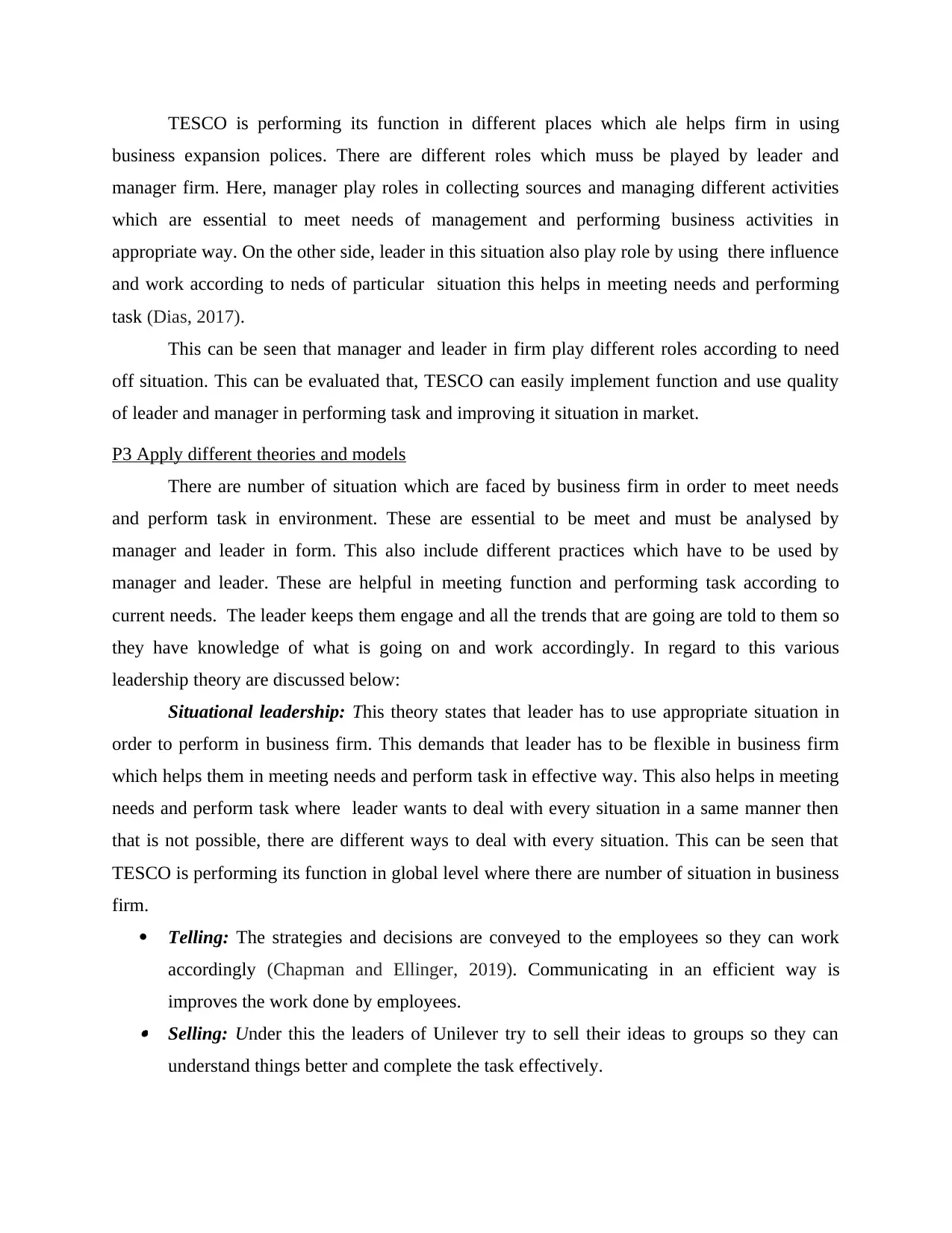
TESCO is performing its function in different places which ale helps firm in using
business expansion polices. There are different roles which muss be played by leader and
manager firm. Here, manager play roles in collecting sources and managing different activities
which are essential to meet needs of management and performing business activities in
appropriate way. On the other side, leader in this situation also play role by using there influence
and work according to neds of particular situation this helps in meeting needs and performing
task (Dias, 2017).
This can be seen that manager and leader in firm play different roles according to need
off situation. This can be evaluated that, TESCO can easily implement function and use quality
of leader and manager in performing task and improving it situation in market.
P3 Apply different theories and models
There are number of situation which are faced by business firm in order to meet needs
and perform task in environment. These are essential to be meet and must be analysed by
manager and leader in form. This also include different practices which have to be used by
manager and leader. These are helpful in meeting function and performing task according to
current needs. The leader keeps them engage and all the trends that are going are told to them so
they have knowledge of what is going on and work accordingly. In regard to this various
leadership theory are discussed below:
Situational leadership: This theory states that leader has to use appropriate situation in
order to perform in business firm. This demands that leader has to be flexible in business firm
which helps them in meeting needs and perform task in effective way. This also helps in meeting
needs and perform task where leader wants to deal with every situation in a same manner then
that is not possible, there are different ways to deal with every situation. This can be seen that
TESCO is performing its function in global level where there are number of situation in business
firm.
Telling: The strategies and decisions are conveyed to the employees so they can work
accordingly (Chapman and Ellinger, 2019). Communicating in an efficient way is
improves the work done by employees. Selling: Under this the leaders of Unilever try to sell their ideas to groups so they can
understand things better and complete the task effectively.
business expansion polices. There are different roles which muss be played by leader and
manager firm. Here, manager play roles in collecting sources and managing different activities
which are essential to meet needs of management and performing business activities in
appropriate way. On the other side, leader in this situation also play role by using there influence
and work according to neds of particular situation this helps in meeting needs and performing
task (Dias, 2017).
This can be seen that manager and leader in firm play different roles according to need
off situation. This can be evaluated that, TESCO can easily implement function and use quality
of leader and manager in performing task and improving it situation in market.
P3 Apply different theories and models
There are number of situation which are faced by business firm in order to meet needs
and perform task in environment. These are essential to be meet and must be analysed by
manager and leader in form. This also include different practices which have to be used by
manager and leader. These are helpful in meeting function and performing task according to
current needs. The leader keeps them engage and all the trends that are going are told to them so
they have knowledge of what is going on and work accordingly. In regard to this various
leadership theory are discussed below:
Situational leadership: This theory states that leader has to use appropriate situation in
order to perform in business firm. This demands that leader has to be flexible in business firm
which helps them in meeting needs and perform task in effective way. This also helps in meeting
needs and perform task where leader wants to deal with every situation in a same manner then
that is not possible, there are different ways to deal with every situation. This can be seen that
TESCO is performing its function in global level where there are number of situation in business
firm.
Telling: The strategies and decisions are conveyed to the employees so they can work
accordingly (Chapman and Ellinger, 2019). Communicating in an efficient way is
improves the work done by employees. Selling: Under this the leaders of Unilever try to sell their ideas to groups so they can
understand things better and complete the task effectively.
⊘ This is a preview!⊘
Do you want full access?
Subscribe today to unlock all pages.

Trusted by 1+ million students worldwide
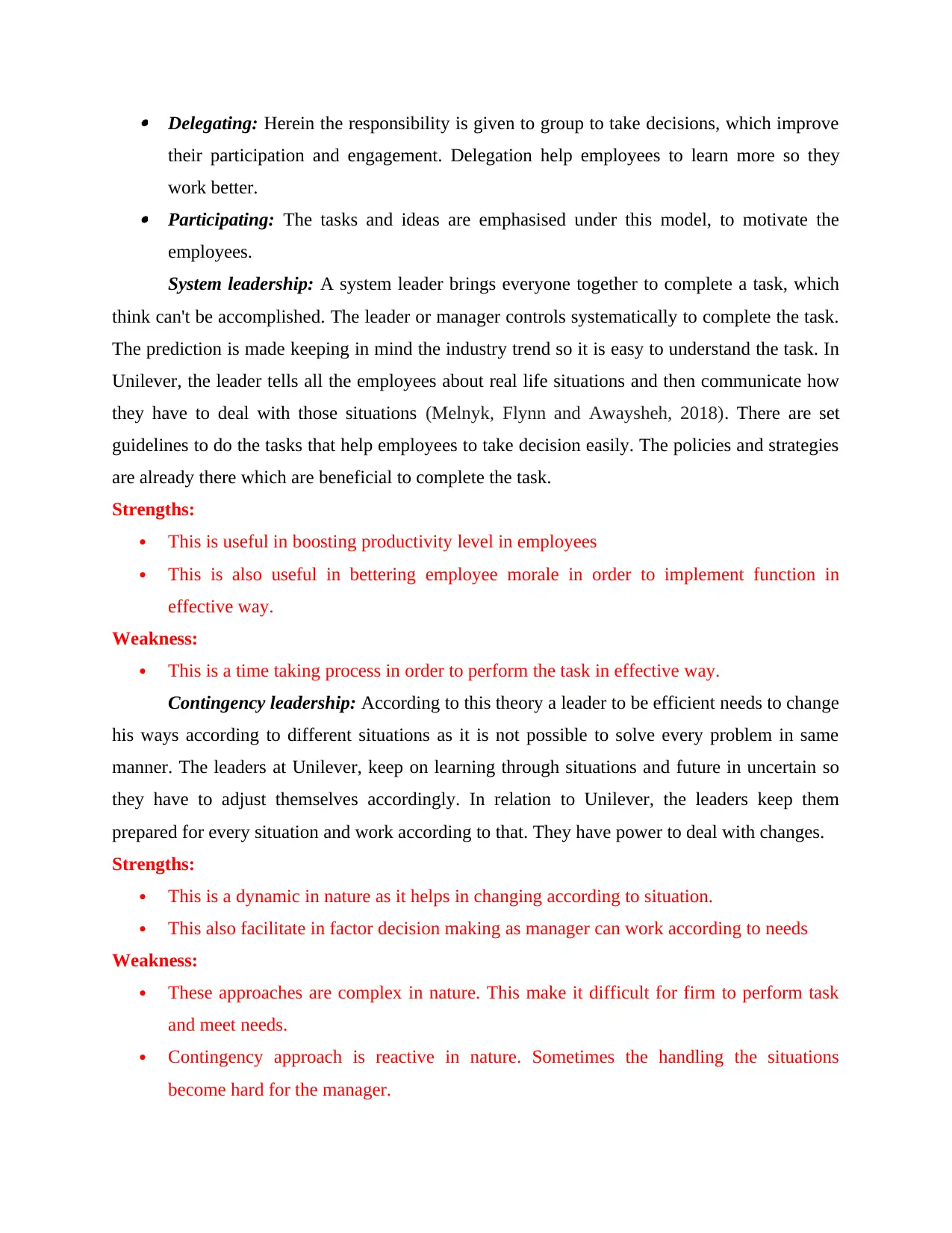
Delegating: Herein the responsibility is given to group to take decisions, which improve
their participation and engagement. Delegation help employees to learn more so they
work better. Participating: The tasks and ideas are emphasised under this model, to motivate the
employees.
System leadership: A system leader brings everyone together to complete a task, which
think can't be accomplished. The leader or manager controls systematically to complete the task.
The prediction is made keeping in mind the industry trend so it is easy to understand the task. In
Unilever, the leader tells all the employees about real life situations and then communicate how
they have to deal with those situations (Melnyk, Flynn and Awaysheh, 2018). There are set
guidelines to do the tasks that help employees to take decision easily. The policies and strategies
are already there which are beneficial to complete the task.
Strengths:
This is useful in boosting productivity level in employees
This is also useful in bettering employee morale in order to implement function in
effective way.
Weakness:
This is a time taking process in order to perform the task in effective way.
Contingency leadership: According to this theory a leader to be efficient needs to change
his ways according to different situations as it is not possible to solve every problem in same
manner. The leaders at Unilever, keep on learning through situations and future in uncertain so
they have to adjust themselves accordingly. In relation to Unilever, the leaders keep them
prepared for every situation and work according to that. They have power to deal with changes.
Strengths:
This is a dynamic in nature as it helps in changing according to situation.
This also facilitate in factor decision making as manager can work according to needs
Weakness:
These approaches are complex in nature. This make it difficult for firm to perform task
and meet needs.
Contingency approach is reactive in nature. Sometimes the handling the situations
become hard for the manager.
their participation and engagement. Delegation help employees to learn more so they
work better. Participating: The tasks and ideas are emphasised under this model, to motivate the
employees.
System leadership: A system leader brings everyone together to complete a task, which
think can't be accomplished. The leader or manager controls systematically to complete the task.
The prediction is made keeping in mind the industry trend so it is easy to understand the task. In
Unilever, the leader tells all the employees about real life situations and then communicate how
they have to deal with those situations (Melnyk, Flynn and Awaysheh, 2018). There are set
guidelines to do the tasks that help employees to take decision easily. The policies and strategies
are already there which are beneficial to complete the task.
Strengths:
This is useful in boosting productivity level in employees
This is also useful in bettering employee morale in order to implement function in
effective way.
Weakness:
This is a time taking process in order to perform the task in effective way.
Contingency leadership: According to this theory a leader to be efficient needs to change
his ways according to different situations as it is not possible to solve every problem in same
manner. The leaders at Unilever, keep on learning through situations and future in uncertain so
they have to adjust themselves accordingly. In relation to Unilever, the leaders keep them
prepared for every situation and work according to that. They have power to deal with changes.
Strengths:
This is a dynamic in nature as it helps in changing according to situation.
This also facilitate in factor decision making as manager can work according to needs
Weakness:
These approaches are complex in nature. This make it difficult for firm to perform task
and meet needs.
Contingency approach is reactive in nature. Sometimes the handling the situations
become hard for the manager.
Paraphrase This Document
Need a fresh take? Get an instant paraphrase of this document with our AI Paraphraser
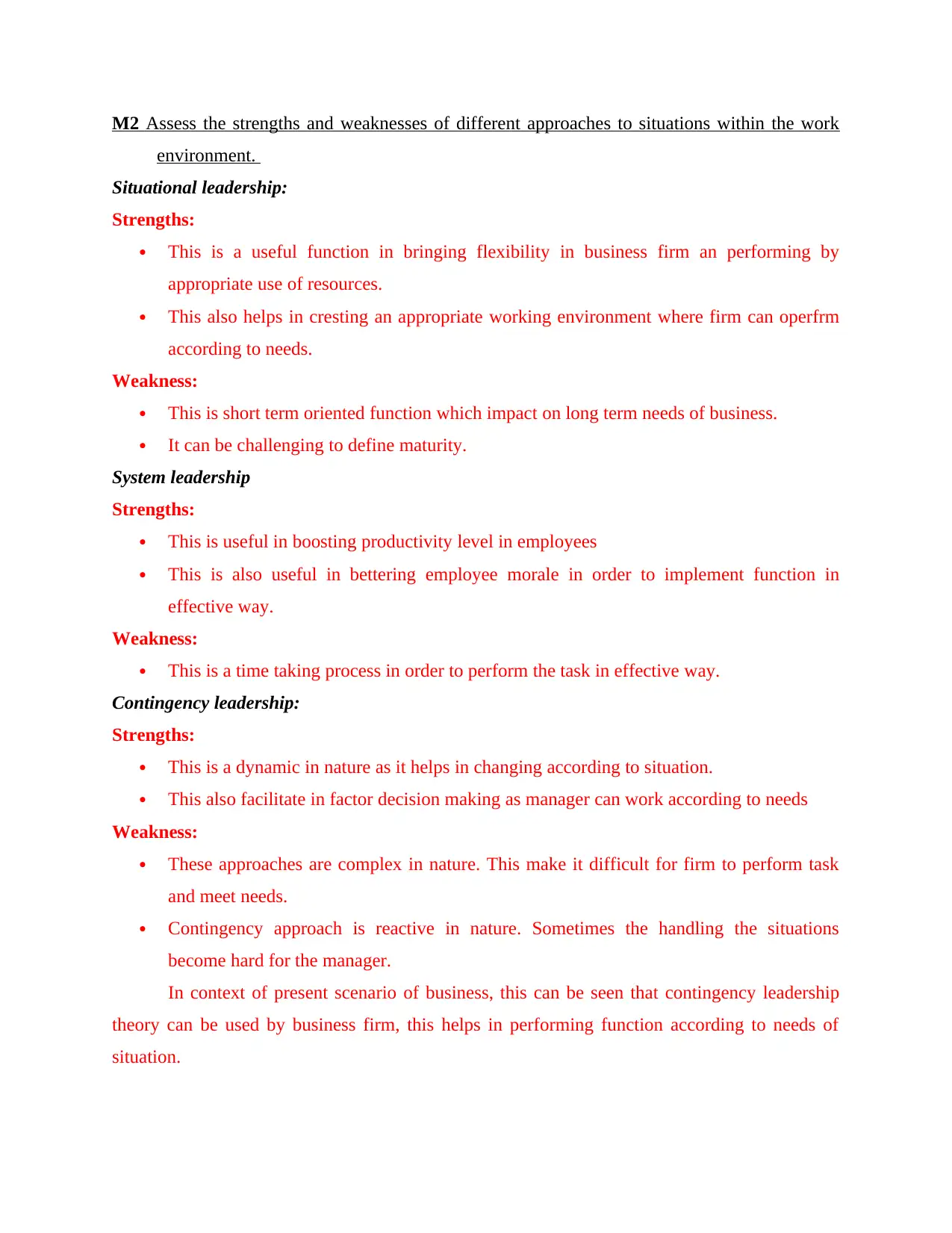
M2 Assess the strengths and weaknesses of different approaches to situations within the work
environment.
Situational leadership:
Strengths:
This is a useful function in bringing flexibility in business firm an performing by
appropriate use of resources.
This also helps in cresting an appropriate working environment where firm can operfrm
according to needs.
Weakness:
This is short term oriented function which impact on long term needs of business.
It can be challenging to define maturity.
System leadership
Strengths:
This is useful in boosting productivity level in employees
This is also useful in bettering employee morale in order to implement function in
effective way.
Weakness:
This is a time taking process in order to perform the task in effective way.
Contingency leadership:
Strengths:
This is a dynamic in nature as it helps in changing according to situation.
This also facilitate in factor decision making as manager can work according to needs
Weakness:
These approaches are complex in nature. This make it difficult for firm to perform task
and meet needs.
Contingency approach is reactive in nature. Sometimes the handling the situations
become hard for the manager.
In context of present scenario of business, this can be seen that contingency leadership
theory can be used by business firm, this helps in performing function according to needs of
situation.
environment.
Situational leadership:
Strengths:
This is a useful function in bringing flexibility in business firm an performing by
appropriate use of resources.
This also helps in cresting an appropriate working environment where firm can operfrm
according to needs.
Weakness:
This is short term oriented function which impact on long term needs of business.
It can be challenging to define maturity.
System leadership
Strengths:
This is useful in boosting productivity level in employees
This is also useful in bettering employee morale in order to implement function in
effective way.
Weakness:
This is a time taking process in order to perform the task in effective way.
Contingency leadership:
Strengths:
This is a dynamic in nature as it helps in changing according to situation.
This also facilitate in factor decision making as manager can work according to needs
Weakness:
These approaches are complex in nature. This make it difficult for firm to perform task
and meet needs.
Contingency approach is reactive in nature. Sometimes the handling the situations
become hard for the manager.
In context of present scenario of business, this can be seen that contingency leadership
theory can be used by business firm, this helps in performing function according to needs of
situation.
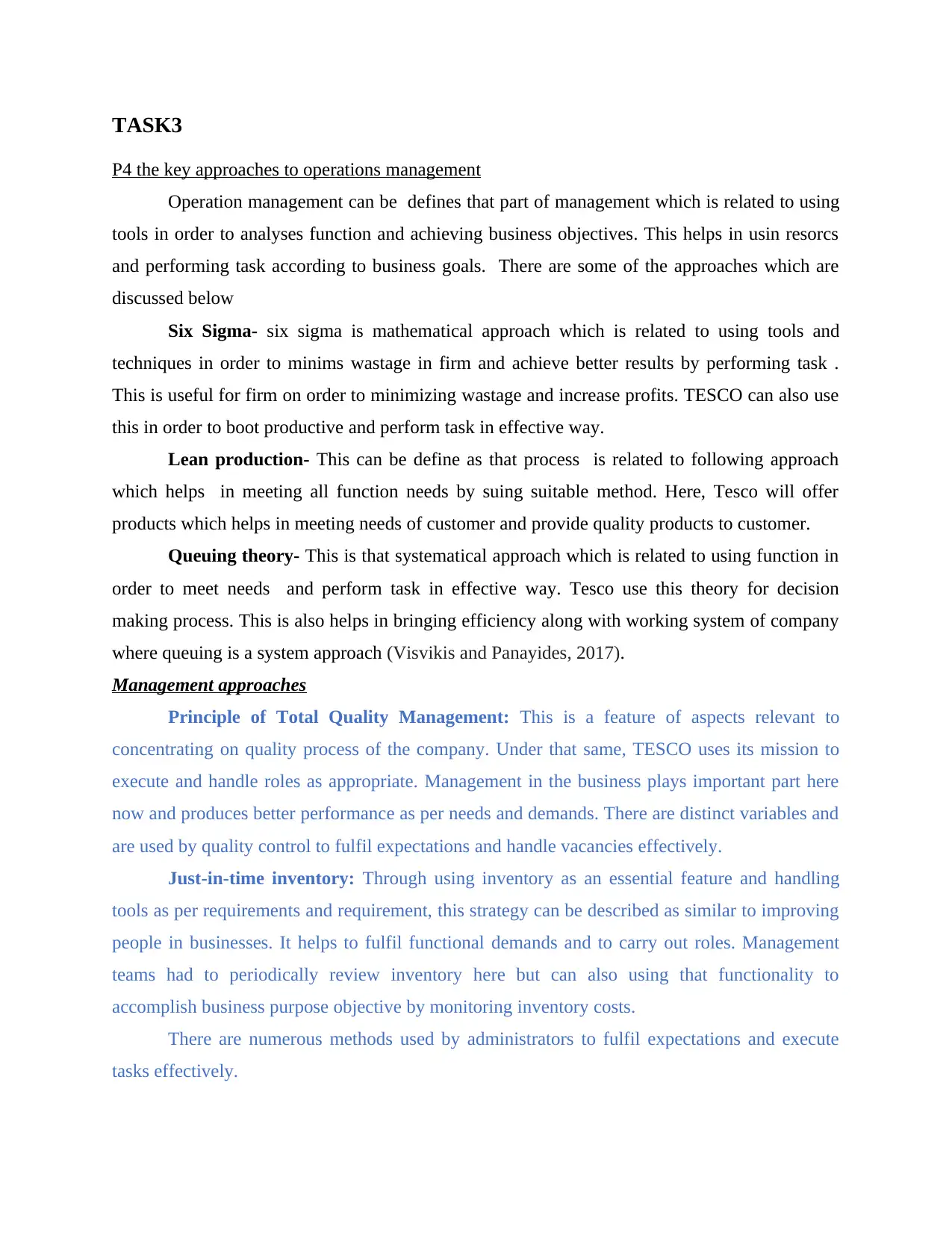
TASK3
P4 the key approaches to operations management
Operation management can be defines that part of management which is related to using
tools in order to analyses function and achieving business objectives. This helps in usin resorcs
and performing task according to business goals. There are some of the approaches which are
discussed below
Six Sigma- six sigma is mathematical approach which is related to using tools and
techniques in order to minims wastage in firm and achieve better results by performing task .
This is useful for firm on order to minimizing wastage and increase profits. TESCO can also use
this in order to boot productive and perform task in effective way.
Lean production- This can be define as that process is related to following approach
which helps in meeting all function needs by suing suitable method. Here, Tesco will offer
products which helps in meeting needs of customer and provide quality products to customer.
Queuing theory- This is that systematical approach which is related to using function in
order to meet needs and perform task in effective way. Tesco use this theory for decision
making process. This is also helps in bringing efficiency along with working system of company
where queuing is a system approach (Visvikis and Panayides, 2017).
Management approaches
Principle of Total Quality Management: This is a feature of aspects relevant to
concentrating on quality process of the company. Under that same, TESCO uses its mission to
execute and handle roles as appropriate. Management in the business plays important part here
now and produces better performance as per needs and demands. There are distinct variables and
are used by quality control to fulfil expectations and handle vacancies effectively.
Just-in-time inventory: Through using inventory as an essential feature and handling
tools as per requirements and requirement, this strategy can be described as similar to improving
people in businesses. It helps to fulfil functional demands and to carry out roles. Management
teams had to periodically review inventory here but can also using that functionality to
accomplish business purpose objective by monitoring inventory costs.
There are numerous methods used by administrators to fulfil expectations and execute
tasks effectively.
P4 the key approaches to operations management
Operation management can be defines that part of management which is related to using
tools in order to analyses function and achieving business objectives. This helps in usin resorcs
and performing task according to business goals. There are some of the approaches which are
discussed below
Six Sigma- six sigma is mathematical approach which is related to using tools and
techniques in order to minims wastage in firm and achieve better results by performing task .
This is useful for firm on order to minimizing wastage and increase profits. TESCO can also use
this in order to boot productive and perform task in effective way.
Lean production- This can be define as that process is related to following approach
which helps in meeting all function needs by suing suitable method. Here, Tesco will offer
products which helps in meeting needs of customer and provide quality products to customer.
Queuing theory- This is that systematical approach which is related to using function in
order to meet needs and perform task in effective way. Tesco use this theory for decision
making process. This is also helps in bringing efficiency along with working system of company
where queuing is a system approach (Visvikis and Panayides, 2017).
Management approaches
Principle of Total Quality Management: This is a feature of aspects relevant to
concentrating on quality process of the company. Under that same, TESCO uses its mission to
execute and handle roles as appropriate. Management in the business plays important part here
now and produces better performance as per needs and demands. There are distinct variables and
are used by quality control to fulfil expectations and handle vacancies effectively.
Just-in-time inventory: Through using inventory as an essential feature and handling
tools as per requirements and requirement, this strategy can be described as similar to improving
people in businesses. It helps to fulfil functional demands and to carry out roles. Management
teams had to periodically review inventory here but can also using that functionality to
accomplish business purpose objective by monitoring inventory costs.
There are numerous methods used by administrators to fulfil expectations and execute
tasks effectively.
⊘ This is a preview!⊘
Do you want full access?
Subscribe today to unlock all pages.

Trusted by 1+ million students worldwide
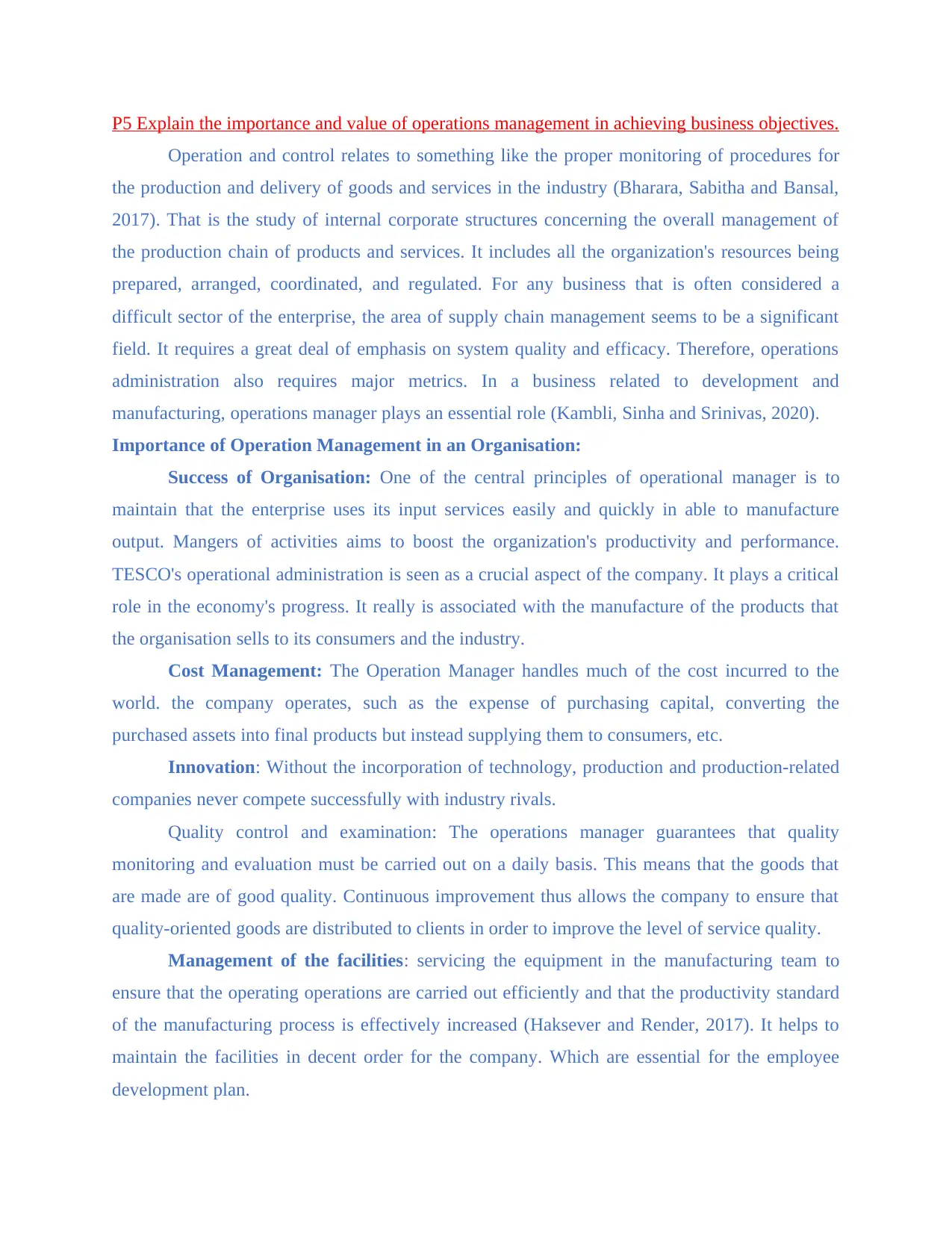
P5 Explain the importance and value of operations management in achieving business objectives.
Operation and control relates to something like the proper monitoring of procedures for
the production and delivery of goods and services in the industry (Bharara, Sabitha and Bansal,
2017). That is the study of internal corporate structures concerning the overall management of
the production chain of products and services. It includes all the organization's resources being
prepared, arranged, coordinated, and regulated. For any business that is often considered a
difficult sector of the enterprise, the area of supply chain management seems to be a significant
field. It requires a great deal of emphasis on system quality and efficacy. Therefore, operations
administration also requires major metrics. In a business related to development and
manufacturing, operations manager plays an essential role (Kambli, Sinha and Srinivas, 2020).
Importance of Operation Management in an Organisation:
Success of Organisation: One of the central principles of operational manager is to
maintain that the enterprise uses its input services easily and quickly in able to manufacture
output. Mangers of activities aims to boost the organization's productivity and performance.
TESCO's operational administration is seen as a crucial aspect of the company. It plays a critical
role in the economy's progress. It really is associated with the manufacture of the products that
the organisation sells to its consumers and the industry.
Cost Management: The Operation Manager handles much of the cost incurred to the
world. the company operates, such as the expense of purchasing capital, converting the
purchased assets into final products but instead supplying them to consumers, etc.
Innovation: Without the incorporation of technology, production and production-related
companies never compete successfully with industry rivals.
Quality control and examination: The operations manager guarantees that quality
monitoring and evaluation must be carried out on a daily basis. This means that the goods that
are made are of good quality. Continuous improvement thus allows the company to ensure that
quality-oriented goods are distributed to clients in order to improve the level of service quality.
Management of the facilities: servicing the equipment in the manufacturing team to
ensure that the operating operations are carried out efficiently and that the productivity standard
of the manufacturing process is effectively increased (Haksever and Render, 2017). It helps to
maintain the facilities in decent order for the company. Which are essential for the employee
development plan.
Operation and control relates to something like the proper monitoring of procedures for
the production and delivery of goods and services in the industry (Bharara, Sabitha and Bansal,
2017). That is the study of internal corporate structures concerning the overall management of
the production chain of products and services. It includes all the organization's resources being
prepared, arranged, coordinated, and regulated. For any business that is often considered a
difficult sector of the enterprise, the area of supply chain management seems to be a significant
field. It requires a great deal of emphasis on system quality and efficacy. Therefore, operations
administration also requires major metrics. In a business related to development and
manufacturing, operations manager plays an essential role (Kambli, Sinha and Srinivas, 2020).
Importance of Operation Management in an Organisation:
Success of Organisation: One of the central principles of operational manager is to
maintain that the enterprise uses its input services easily and quickly in able to manufacture
output. Mangers of activities aims to boost the organization's productivity and performance.
TESCO's operational administration is seen as a crucial aspect of the company. It plays a critical
role in the economy's progress. It really is associated with the manufacture of the products that
the organisation sells to its consumers and the industry.
Cost Management: The Operation Manager handles much of the cost incurred to the
world. the company operates, such as the expense of purchasing capital, converting the
purchased assets into final products but instead supplying them to consumers, etc.
Innovation: Without the incorporation of technology, production and production-related
companies never compete successfully with industry rivals.
Quality control and examination: The operations manager guarantees that quality
monitoring and evaluation must be carried out on a daily basis. This means that the goods that
are made are of good quality. Continuous improvement thus allows the company to ensure that
quality-oriented goods are distributed to clients in order to improve the level of service quality.
Management of the facilities: servicing the equipment in the manufacturing team to
ensure that the operating operations are carried out efficiently and that the productivity standard
of the manufacturing process is effectively increased (Haksever and Render, 2017). It helps to
maintain the facilities in decent order for the company. Which are essential for the employee
development plan.
Paraphrase This Document
Need a fresh take? Get an instant paraphrase of this document with our AI Paraphraser
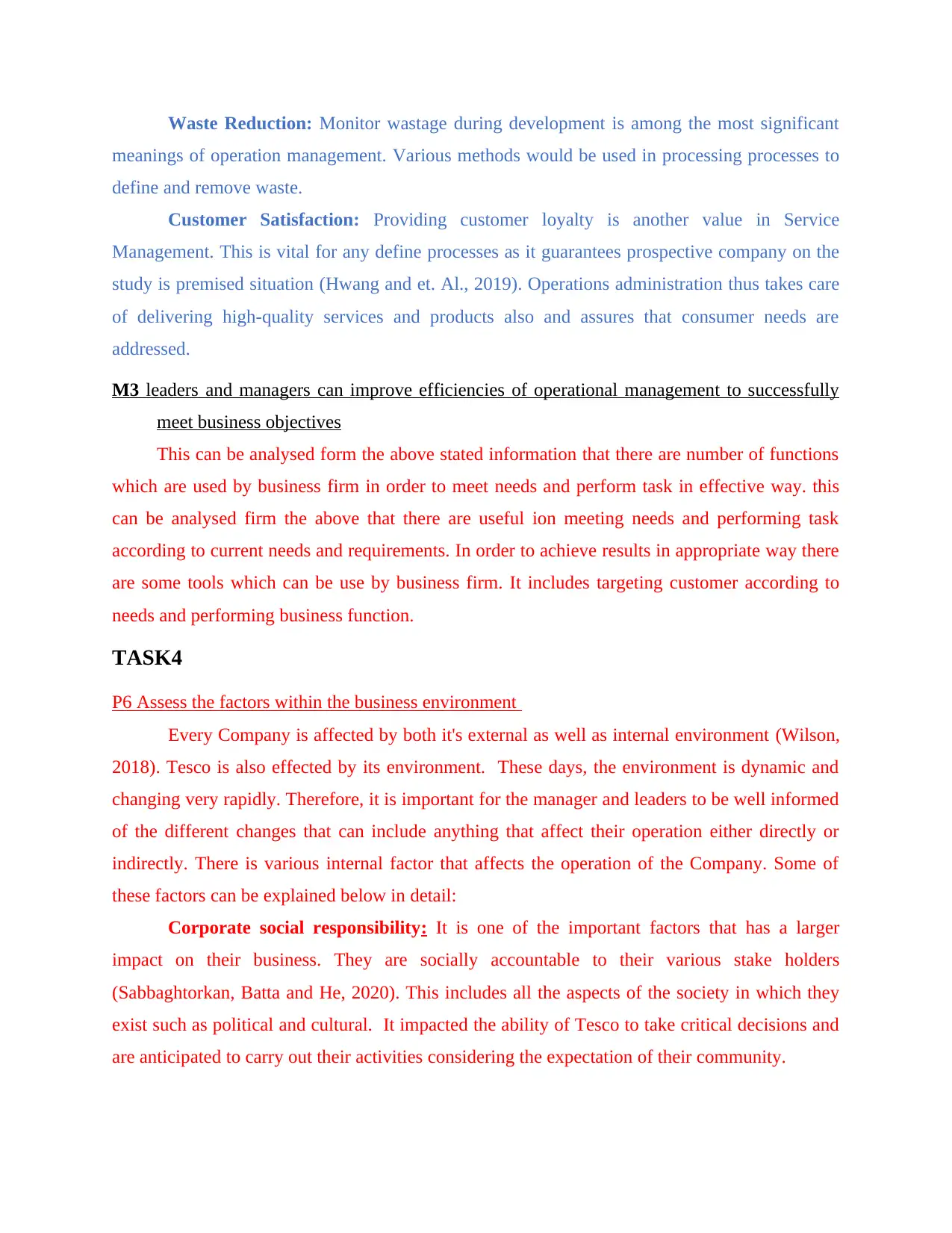
Waste Reduction: Monitor wastage during development is among the most significant
meanings of operation management. Various methods would be used in processing processes to
define and remove waste.
Customer Satisfaction: Providing customer loyalty is another value in Service
Management. This is vital for any define processes as it guarantees prospective company on the
study is premised situation (Hwang and et. Al., 2019). Operations administration thus takes care
of delivering high-quality services and products also and assures that consumer needs are
addressed.
M3 leaders and managers can improve efficiencies of operational management to successfully
meet business objectives
This can be analysed form the above stated information that there are number of functions
which are used by business firm in order to meet needs and perform task in effective way. this
can be analysed firm the above that there are useful ion meeting needs and performing task
according to current needs and requirements. In order to achieve results in appropriate way there
are some tools which can be use by business firm. It includes targeting customer according to
needs and performing business function.
TASK4
P6 Assess the factors within the business environment
Every Company is affected by both it's external as well as internal environment (Wilson,
2018). Tesco is also effected by its environment. These days, the environment is dynamic and
changing very rapidly. Therefore, it is important for the manager and leaders to be well informed
of the different changes that can include anything that affect their operation either directly or
indirectly. There is various internal factor that affects the operation of the Company. Some of
these factors can be explained below in detail:
Corporate social responsibility: It is one of the important factors that has a larger
impact on their business. They are socially accountable to their various stake holders
(Sabbaghtorkan, Batta and He, 2020). This includes all the aspects of the society in which they
exist such as political and cultural. It impacted the ability of Tesco to take critical decisions and
are anticipated to carry out their activities considering the expectation of their community.
meanings of operation management. Various methods would be used in processing processes to
define and remove waste.
Customer Satisfaction: Providing customer loyalty is another value in Service
Management. This is vital for any define processes as it guarantees prospective company on the
study is premised situation (Hwang and et. Al., 2019). Operations administration thus takes care
of delivering high-quality services and products also and assures that consumer needs are
addressed.
M3 leaders and managers can improve efficiencies of operational management to successfully
meet business objectives
This can be analysed form the above stated information that there are number of functions
which are used by business firm in order to meet needs and perform task in effective way. this
can be analysed firm the above that there are useful ion meeting needs and performing task
according to current needs and requirements. In order to achieve results in appropriate way there
are some tools which can be use by business firm. It includes targeting customer according to
needs and performing business function.
TASK4
P6 Assess the factors within the business environment
Every Company is affected by both it's external as well as internal environment (Wilson,
2018). Tesco is also effected by its environment. These days, the environment is dynamic and
changing very rapidly. Therefore, it is important for the manager and leaders to be well informed
of the different changes that can include anything that affect their operation either directly or
indirectly. There is various internal factor that affects the operation of the Company. Some of
these factors can be explained below in detail:
Corporate social responsibility: It is one of the important factors that has a larger
impact on their business. They are socially accountable to their various stake holders
(Sabbaghtorkan, Batta and He, 2020). This includes all the aspects of the society in which they
exist such as political and cultural. It impacted the ability of Tesco to take critical decisions and
are anticipated to carry out their activities considering the expectation of their community.
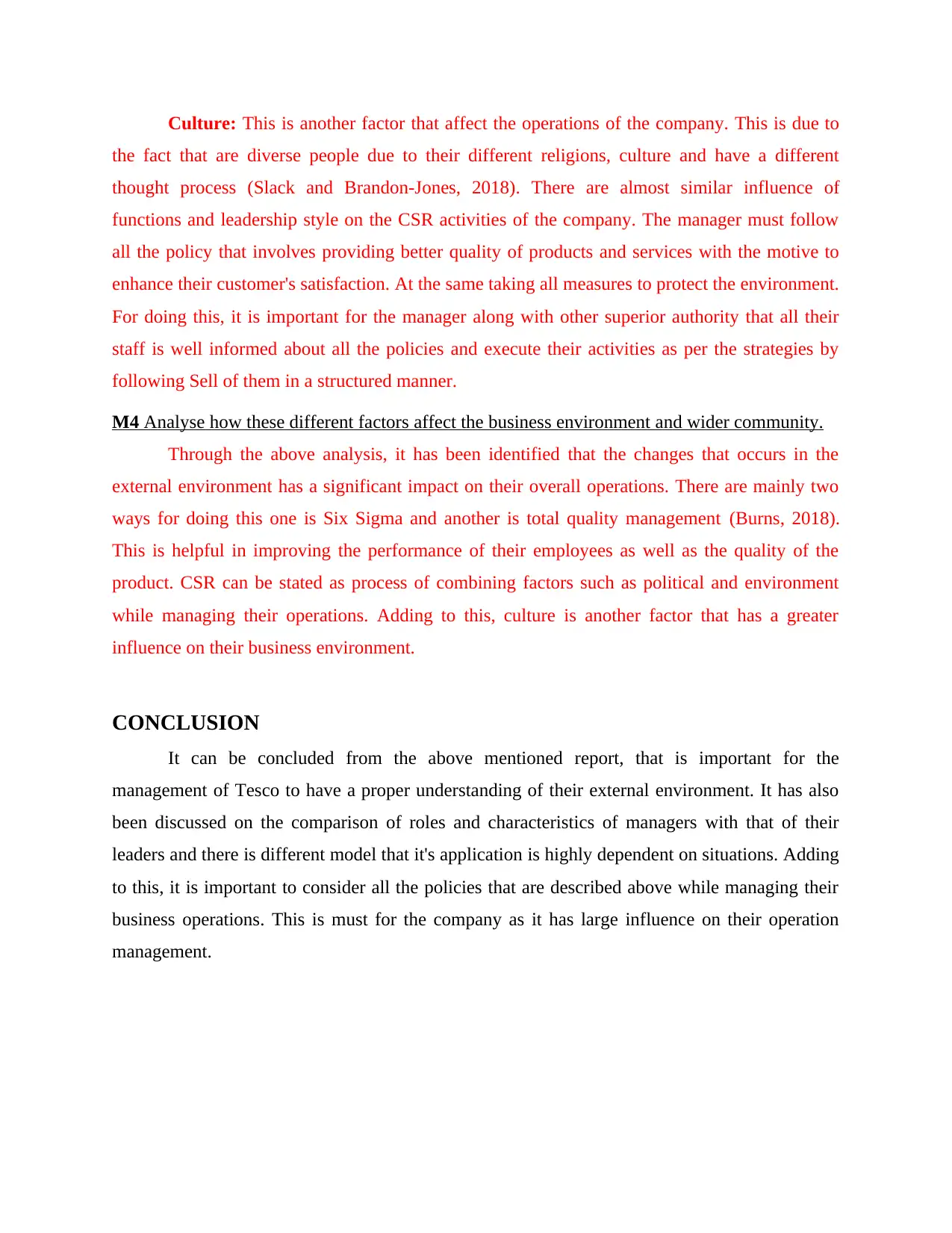
Culture: This is another factor that affect the operations of the company. This is due to
the fact that are diverse people due to their different religions, culture and have a different
thought process (Slack and Brandon-Jones, 2018). There are almost similar influence of
functions and leadership style on the CSR activities of the company. The manager must follow
all the policy that involves providing better quality of products and services with the motive to
enhance their customer's satisfaction. At the same taking all measures to protect the environment.
For doing this, it is important for the manager along with other superior authority that all their
staff is well informed about all the policies and execute their activities as per the strategies by
following Sell of them in a structured manner.
M4 Analyse how these different factors affect the business environment and wider community.
Through the above analysis, it has been identified that the changes that occurs in the
external environment has a significant impact on their overall operations. There are mainly two
ways for doing this one is Six Sigma and another is total quality management (Burns, 2018).
This is helpful in improving the performance of their employees as well as the quality of the
product. CSR can be stated as process of combining factors such as political and environment
while managing their operations. Adding to this, culture is another factor that has a greater
influence on their business environment.
CONCLUSION
It can be concluded from the above mentioned report, that is important for the
management of Tesco to have a proper understanding of their external environment. It has also
been discussed on the comparison of roles and characteristics of managers with that of their
leaders and there is different model that it's application is highly dependent on situations. Adding
to this, it is important to consider all the policies that are described above while managing their
business operations. This is must for the company as it has large influence on their operation
management.
the fact that are diverse people due to their different religions, culture and have a different
thought process (Slack and Brandon-Jones, 2018). There are almost similar influence of
functions and leadership style on the CSR activities of the company. The manager must follow
all the policy that involves providing better quality of products and services with the motive to
enhance their customer's satisfaction. At the same taking all measures to protect the environment.
For doing this, it is important for the manager along with other superior authority that all their
staff is well informed about all the policies and execute their activities as per the strategies by
following Sell of them in a structured manner.
M4 Analyse how these different factors affect the business environment and wider community.
Through the above analysis, it has been identified that the changes that occurs in the
external environment has a significant impact on their overall operations. There are mainly two
ways for doing this one is Six Sigma and another is total quality management (Burns, 2018).
This is helpful in improving the performance of their employees as well as the quality of the
product. CSR can be stated as process of combining factors such as political and environment
while managing their operations. Adding to this, culture is another factor that has a greater
influence on their business environment.
CONCLUSION
It can be concluded from the above mentioned report, that is important for the
management of Tesco to have a proper understanding of their external environment. It has also
been discussed on the comparison of roles and characteristics of managers with that of their
leaders and there is different model that it's application is highly dependent on situations. Adding
to this, it is important to consider all the policies that are described above while managing their
business operations. This is must for the company as it has large influence on their operation
management.
⊘ This is a preview!⊘
Do you want full access?
Subscribe today to unlock all pages.

Trusted by 1+ million students worldwide
1 out of 14
Related Documents
Your All-in-One AI-Powered Toolkit for Academic Success.
+13062052269
info@desklib.com
Available 24*7 on WhatsApp / Email
![[object Object]](/_next/static/media/star-bottom.7253800d.svg)
Unlock your academic potential
Copyright © 2020–2025 A2Z Services. All Rights Reserved. Developed and managed by ZUCOL.




